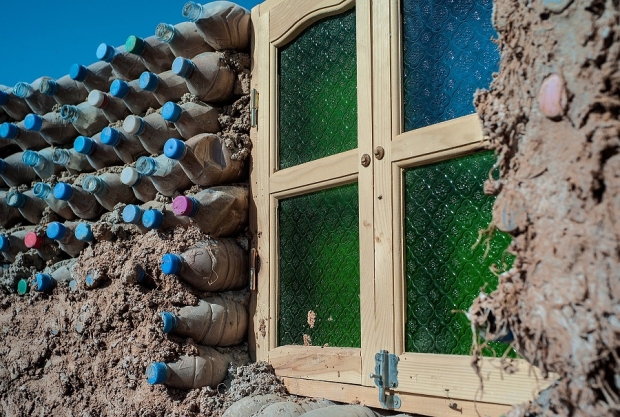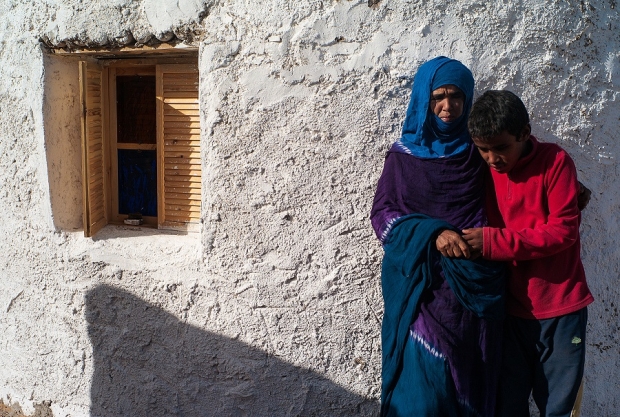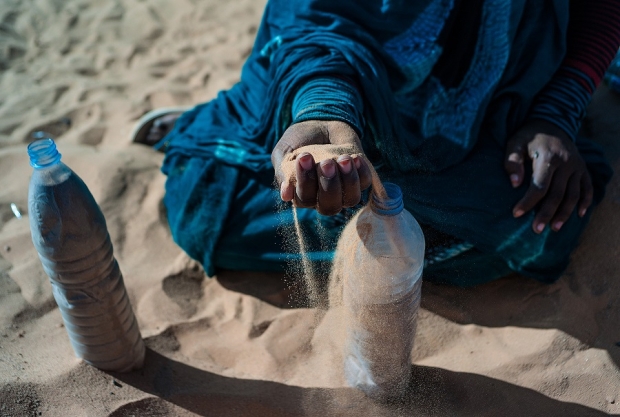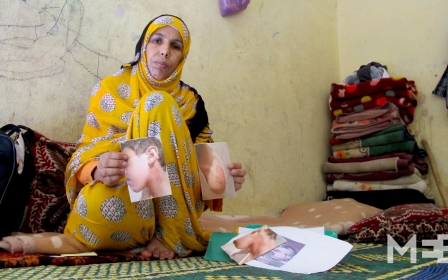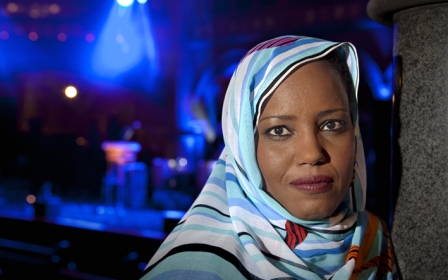Meet the Sahrawi refugee building homes from plastic bottles in the desert

TINDOUF, Algeria - With temperatures soaring beyond 50 degrees Celsius and sand storms wrecking havoc on the Sahrawi refugees inhabiting the adobe houses and tents of the refugee camps around Tindouf, western Algeria, the region has been aptly named, the Devil's Garden.
Young Sahrawi engineer, Tateh Lehbib, 28, found an answer to their woes: all they needed to rebuild a home in this arid land was 6,000 plastic bottles.
"A plastic bottle is 20 times more resistant than an adobe brick," the young Sahrawi engineer emphasised.
'A plastic bottle is 20 times more resistant than an adobe brick'
-Tateh Lehbib, Sahrawi engineer
Lehbib's project has been backed by the United Nations Agency for Refugees (UNHCR) with a budget of 60,000 euros. He has so far built 26 houses with 80 percent of the materials used being recycled plastic, straw, earth and cardboard. The bottles that make up the base and structure of the walls are either used one- or two-litre water or soda bottles, which can be found in the camps and the dumps.
"The objective is to alleviate the suffering of the Sahrawi, letting them live with more dignity, and to build ecological and sustainable homes," explained the engineer.
"This prevents the house from getting hot, even lowering the temperature to 5° C," said Lehbib.
'The objective is to alleviate the suffering of the Sahrawi, letting them live with more dignity, and to build ecological and sustainable homes'
-Tateh Lehbib, Sahrawi engineer
The round shape of the building was carefully chosen as well. According to Lehbib, the shape avoids "light rays entering directly, which reduces heat flow". Two windows at different heights allow for better ventilation.
Additionally, the rounded exterior prevents sand from accumulating on the outside of the structure during sandstorms, which is a common occurrence in typical adobe square houses of the camp. "When a very strong one arrives, the dunes can reach the top of the roof," Lehbib said.
"I will use [the plastic house] to receive friends, make tea and take a nap," Hassan said. "It has less risk and is less dangerous in case of collapse. The adobe houses can crush us if they fall because the roofs are [made from] metal," Hassan pointed out, referring to the zinc roofs.
'I will use [the plastic house] to receive friends, make tea and take a nap'
-Mohamed Salem Hassan, Sahrawi refugee
Sixteen-year-old Abdeljalil Nafe is blind and autistic. Since November 2016, playing and resting in the shade is now possible in the "plastic house" during the hottest hours of the day.
"My son sleeps at night in it and he also plays in it. Before, he was in a tent of cloth with a roof of zinc sheet, and often the fabrics and the wood broke,” declared the boy's mother Albatul Kadiri.
The recycled houses offer a cool space compared to homes topped with zinc roofs, as it is one of the best conductors for heat, according to Lehbib.
“It is much more comfortable in the plastic house. In his other [previous] room, the temperature was very high, sometimes unbearable,” Kadiri said. "At first, when it was being built, my neighbours looked at us in surprise, but now they are very interested in knowing what it's like inside."
According to Lehbib, when time is of the essence, this single-family dwelling can be built in one week at the cost of around 250 euros, which is much cheaper than building a mud-brick house which can cost up to 1,000 euros.
'At first, they called me 'the crazy bottle man'
-Tateh Lehbib, Sahrawi engineer
Though there is a lack of formal recycling methods in this part of the world, making use of potentially toxic plastic is their way of contributing "environmentally friendly" housing to the planet.
"The large amount of plastic bottles that we use every day end up lying in the camps and poison the environment," Lehbib said. "We do not have the recycling industry that exists in Western countries, so this is our way of recycling."
The first plastic house
In 2013, Lehbib graduated in Renewable Energies from Tlemcen University in Algeria. Thanks to an Erasmus Mundus scholarship from the European Union, he is continuing his studies for a postgraduate degree in energy efficiency from the University of Las Palmas de Gran Canaria in Spain.
When Lehbib is not living in Spain, he still lives with his grandmother in the refugee camps of Tindouf. Together they share in the traditions of Sahrawi families by having both a tent and an adobe home.
Yet after torrential rains in October 2015, he built the first plastic house for her to help her lead an easier life.
"I wanted her not to suffer so much from the heat, and to lead a better, more comfortable life."
'We do not have the recycling industry that exists in Western countries, so this is our way of recycling'
-Tateh Lehbib, Sahrawi engineer
'The Crazy bottle man'
But these constructions were not always welcomed with enthusiasm by the refugees, who did not trust that a strong, stable house could be built with plastic bottles.
"At first, they called me 'the crazy bottle man'. Once built and seen with their own eyes, my compatriots understand the project better," he said.
Lehbib also pointed out the difficulty in laying out furniture and carpets in the round house, as they are usually designed in linear shapes.
"We are testing alternatives so that the house is round outside, but square inside, so that they can place their belongings on shelves. This modification would not affect the original idea," he said. "It is also important to make it bigger and spacious because the Sahrawis need a very wide space to welcome guests and make tea."
Once these problems have been solved, the next step will be for the housing to accommodate an entire family, rather than its current capacity of one person.
"In the near future we will make whole houses. Having a kitchen, for example, would be very important."
'We are creating an industry around plastic houses'
- Tateh Lehbib, Sahrawi engineer
People in the camps were not the only ones to notice the benefits of these new homes - the United Nations did as well.
In 2016, UNHCR selected Lehbib's plastic home project from out of 3,000 other proposals to be developed with a budget of 60,000 euros. As a result, the other 25 homes were funded by UNHCR.
The project also helped employ several people to build the houses, giving a boost to the local economy.
"In fact, we are creating an industry around plastic houses,” he added.
History of Sahrawi refugees
More than 165,000 Sahrawi's have been living a life of exile in the area surrounding Tindouf, Algeria, for the last 42 years, after fleeing Moroccan forces during the Western Saharan War. They are waiting for an independence referendum that was promised to them by the United Nations when a ceasefire with Morocco was established in 1991, following Spain's failed decolonisation in 1976.
In 2015, torrential rain affected 25,000 Sahrawi refugees, whose homes were either damaged or destroyed, in addition to nurseries, schools, medical centres and food dispensaries.
Protecting the environment
Lehbib believes that his homes offer an answer to some of the world's environmental problems.
"We are not only protecting the environment of the camps, but the whole world because the great countries meet every year to talk about climate change, but they cannot reach almost any agreement," he said.
"We all know that plastic does not get undone in nature until after hundreds of years. There are estimates that the number is more than 300 years, and that's how long these homes will survive, as long as the bottles are not exposed to the sun," he added.
The UN Environment Programme (UNEP) has stated in the report, Biodegradable Plastics and Marine Waste, that 280 million tonnes of plastic are manufactured every year worldwide, and very little of it is recycled. To make matters worse, 20 million tonnes of this plastic waste ends up in the oceans.
"Every day millions of tonnes of plastic are thrown away and there are [around] 65 million refugees in the world. It would be a good resource for all of them as well,” concludes Lehbib.
This article is available in French on Middle East Eye French edition.
Middle East Eye propose une couverture et une analyse indépendantes et incomparables du Moyen-Orient, de l’Afrique du Nord et d’autres régions du monde. Pour en savoir plus sur la reprise de ce contenu et les frais qui s’appliquent, veuillez remplir ce formulaire [en anglais]. Pour en savoir plus sur MEE, cliquez ici [en anglais].


